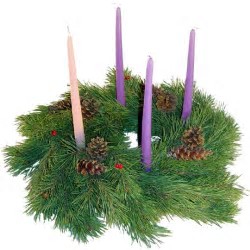A wreath, usually of greenery, to which are attached candles, invented by the reforming Lutheran pastor Johann Hinrich Wichern. In Hamburg in 1833 he opened the “Rauhe Haus”, the Rough House, which sheltered orphaned or neglected children. In order to make the Christmas story more real to them every night of Advent he told them stories, prayed and lit a candle. To accommodate the candles a wheel-shaped chandelier was built, around which evergreens were twined. Visitors and supporters were impressed by this display and the custom spread but those who imitated it reduced it in size to four candles, one for each week of Advent.
Many churches and homes mark the progress of Advent by lighting one additional candle a week until on the final Sunday all four are alight. Three of these candles are purple or violet (penitential colours) while the one lit on the third Sunday (Gaudete Sunday) is the pink of rejoicing. After Christmas these candles are often replaced with white ones.
The candles represent the coming of Jesus, the Light of the World, and it was once customary for someone named John or Joan to be first to light them because John the Baptist at the River Jordan was the first to see the fire of divinity in Jesus and John the Evangelist began his gospel by referring to Jesus as the Light. The wreath is an ancient symbol of victory while the greenery represents the ever-lasting life.
A German variation on the Advent wreath is a seven-branched candle-holder. In the southwestern United States the wreath is occasionally made from bunches of red chili peppers. Acadians in the Canadian Maritime provinces fashion their Advent wreaths in the form of a cross and place them at the foot of the church altar.
The world’s largest Advent Wreath takes up a whole city block in Münster, Germany.
